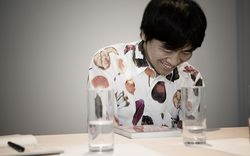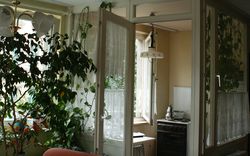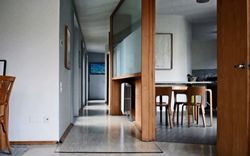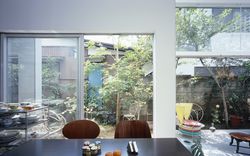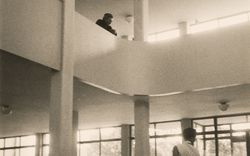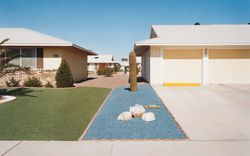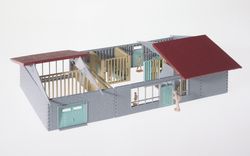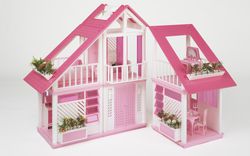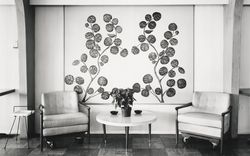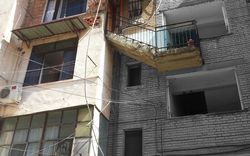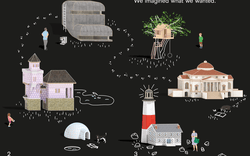Redefining Habitation in a Messy Urban Context
A discussion between Giovanna Borasi, Ryue Nishizawa, and Stephen Taylor
- GB
- Ryue and Stephen, you both live in the cities that are the subject of our exhibition. So, I would like to start this conversation by speaking about your experience as inhabitants more than as architects in the city. Ryue, how is living in Tokyo?
- RN
- How is living in Tokyo for me? I’m not sure I can say I’m living in Tokyo. I’m always going somewhere else. Maybe I could say something on certain aspects of Japanese society and culture that influence the way we live in our cities. Japanese society is over-defined. Sidewalks are, for example, where you must walk. Here is … where you must drive. Then if you would like to ride a bicycle there, no, it’s not possible! (Laughs.) And if you are in one of these flows of pedestrians and you would like to stop, normally it is not possible. And if you could stop, in ten seconds you must resume walking. Even the way we conceive the use of land is defined: a piece of land is somewhere you must build a house. In public areas in the city, such as a park, for example, you could not play tennis or baseball. You can walk with a dog, but you can’t walk with a monkey. Japanese society is well-defined, regulated. Too much, maybe.
- GB
- From what you are saying, Ryue, it seems that Japanese society defines firm rules and behaviours for people in the city, in the streets, but could you say that in private spaces, inside the houses, in the family, it is the same? Or are these attitudes less present inside the house?
- RN
- In a standard house built according to traditional values, I think it is exactly the same. But personally, I’m an architect who is trained to break with tradition, so maybe I have a particular point of view. But there are a few things that are characteristic of Japanese culture which are nice that I would like to add. Japanese are casual people and basically they are happy people. Even if there are all these regulations and a constant desire to properly define every aspect of cohabitation, our cities seem very disorganized. What I find interesting is that they give the impression that anything is possible. Japan doesn’t look like a conservative country. Actually, Japanese are basically a little bit conservative…but very informal and open. Casual, I’d say.
- GB
- And what about London?
- ST
- To live? Or to work? I think it’s a city where to live or to work are two different questions. Generally, it’s maybe a good city to live a life. It’s a huge city: 7.5 million people occupying six hundred square miles. It is an incredibly low-density city, where over 50 percent of the city is covered not by buildings or streets or public spaces, but private back gardens. London is a city of houses, houses rather than apartments. It’s also a very varied city, a city of villages where these villages have grown and connected, and now become this great conglomerate. But you know, within this mix, I think it’s a very good time to be an architect in London. There are a lot of gaps, a lot of holes, a lot to do. Compared, say, with a city like Paris, where it’s kind of finished and fixed, or set-piece cities like Bath, I think London has a lot of opportunities. But as a place to live, you know… For me it’s a fantastic city to live, but it’s expensive, it’s difficult, it’s sprawling. It’s long journeys between home and work with a transport system that’s exhausted.
Read more
- GB
- In your projects you both are proposing a specific idea of lifestyle. One of the aims of this exhibition was in fact to establish a clear connection between the culture of a place, of a city and the way of living in it. I know that now, Ryue, you are doing new projects outside of Japan: a house in Europe with Kazuyo Sejima, and also a residential project in the United States. Do you think the way of life that you are proposing in your Japanese houses is, in fact, related to Tokyo, and when you design these other houses framed by new conditions, will you imagine that the life inside them, the way of using space, their relationship with their surroundings will be different, or will you build these projects on the same ideas?
- RN
- I would like my projects to be local. But at the same time I hope that my projects can also be understood and appreciated by somebody who lives outside this locality. And I hope my project is convincing to people who do not belong to the Japanese culture. But basically, I think architecture relates to specific surroundings which you can’t exchange.
- GB
- So, it will be interesting to see these new residential projects you are designing and how they will relate to different cultures and different climates. I’m curious to see if, for example, they will be characterized by the same idea of openness that is present in your latest residential projects that we see here in the exhibition.
- RN
- Openness. In fact, it is a quality that you could find in most of my projects. I have to admit that I don’t know where it comes from. Maybe the atmosphere or the history of Japan influenced me. It might come from the climate also. In Japan we have four seasons which are not extremely severe. Following the traditional lifestyle, people are invited to use their gardens and the streets in a very open way: Japanese people know how to enjoy spring, summer, autumn, and the rich quality of life that these different times bring.
- GB
- I like this idea of an architecture and a society that relate to the climate, and a building that works differently in the four seasons. I find that this idea brings a different perspective and becomes particularly relevant at this moment when everybody is trying to find his path towards a more “sustainable” society.
- ST
- And how does it work in winter? I’m interested in understanding, for example, in the Moriyama House, the use of all these spaces between houses.
- RN
- I think ten or fifteen years ago, it would have been difficult. But recently the quality of the technical aspects in construction is getting higher; we have very efficient, high-insulation glass with more transparency—and floor heating, for example. In Japan, traditionally, we didn’t have such good heating systems for our houses. But people started to learn the European way, and I think things are getting a little better.
- ST
- And typically, how do they heat their houses? Is it with gas or electricity?
- RN
- It is mainly electricity, but we use gas for heating purposes, too. But for a cooling system in summer, normally people use electricity. With electricity everything can be done in a very simple way: just install the machine. This is cheap and easy, and this is one of the most typical things that people do.
- ST
- So it’s very typical to use free-standing air conditioning units within the facade of a building?
- RN
- Yes. People don’t care. They don’t know what city means, so they don’t care.
- GB
- And what do you think, Stephen? Now you are involved in these projects in London, and maybe in the future you will develop other projects in different cultures, in other places. How do you imagine you will relate to a new context?
- ST
- I like this idea of a project being local. My two built housing projects that are part of the exhibition [Chance Street and Charlotte Road] are very much about the city, about delighting in the city and creating a kind of refuge within the city in spite of sometimes difficult situations. A building site that has, for example, only a small piece of elevation to the street, how can you exploit that to create a good experience for inhabitants in terms of light and air, in terms of sequences of spaces? So, maybe it’s an obvious thing to say, but for me there’s a pleasure in creating a generosity within what might be tough and limited conditions.
- GB
- Even if the density in Tokyo and London are very different, many of your projects have in common the fact that they are built in a compact context, where light and air are defining many aspects of the projects. I’m thinking of Charlotte Road which has no rear openings and of Garden and House which is surrounded by tall buildings, for example. In a way it is interesting for me to see that these two simple aspects are determining many of the architectural decisions and at the same time defining the interior atmosphere of the house and its exchange with the exterior. The “landscape” roof of Charlotte Road comes from these constraints, the “absence” of walls in Garden and House, too.
- RN
- I think so, very much.
- GB
- I would like to understand also from you both how a house relates to the social life in the city. In fact, many of your projects are very small and located in the city core. There are many books that have come out recently on Tokyo, for example, about the fact that if you live in a dense context and you have the entire city around you, then you could have easy access to bars, restaurants, wireless everywhere, so maybe you don’t need all the traditional “functions” in your house anymore. Last night, Ryue, you were explaining to me that in your house you don’t have a kitchen and not even a fridge… So, I’m curious to know if you are considering including these changes and new urban conditions in your future projects. Do you still think that the house needs all its functions, or is there a part that you, personally, can live without?
- RN
- (Laughs.) I’m extreme. I think inside a house it is nice to have something that connects you to something very far away. We have a computer, and we get close to each other, and we can have a very good, intimate network. But when this happens, I think maybe we had better be in a space which is very isolated from the others. This will be the right way for a house in Tokyo. What I am thinking is that the house must be very open to have some relation to the neighbours and the city, but at the same time the house must be very private. For yourself. This doesn’t mean enclosed. This doesn’t mean a space similar to a jailhouse. I think you can do both without sacrificing one of them.
So, this is what I would like to achieve with my housing projects, to find an equilibrium between the fact that a house could be open to the city, but still keep some intimacy. This duality, this tension, it’s interesting to me. In the past, there was a standard lifestyle in Japan. Like, you must get married and live with your partner. Then, you must have three kids. And you must live in suburbia, and you must take the train to get to the city, commute all the time. This kind of lifestyle was common. And, if you have money or a bit more, you can also buy a second house in nature to enjoy. All this sounds to me a little bit strange. A house to enjoy and a house for work. I can understand this kind of lifestyle became the standard. But I don’t think this fits today’s needs, as everybody is living in a different way. So in my experience, working, living, sleeping, everything is the same. Everything is continuous. Everything is my life. So I think people must enjoy every moment… You cannot divide life into two parts: one to enjoy; the other to struggle. No? So, I am now trying to decide what kind of lifestyle or what kind of typology or what kind of space will be the right one for our contemporary life. - ST
- I think that’s absolutely right. At this moment when everyone is addressing the question of sustainability in terms of insulation and solar panels, the idea of making a habitable life in the core or the centre of a city is very much part of the answer. To make it a kind of a human pleasure to return home to a place of tranquility and privacy on one level, but connected to the community on another. It’s about providing a degree of openness while structuring the timing throughout the day to which that openness is acceptable.
I think it is up to the skill of the architect to not close the house off to the street, but to find ways to manage privacy, whether it is a window with a curtain or through the composition and materiality of a facade. It’s about letting air and light through, giving glimpses somehow and at night letting internal lights illuminate the street. I think what Ryue was just describing, this notion of the two homes phenomenon, exists in London too. I think it’s a condition of our age, in a way, this sort of second home phenomenon. But, it’s the idea that on a Friday night you leave town and go somewhere which is pleasurable when in fact, you are joining the rest of the commuters for two hours to go out to the countryside and then on Sunday night you join them again to come back. It will be different if the place in town is a place of pleasure; and not only that, you also have the benefit of the city.
- GB
- Stephen, do you think in London it will be possible to propose some of the ideas we just discussed with Ryue? For example, a house without a kitchen? Or to redefine completely the use and the hierarchies between rooms? For example, as in House A, each room could be used as a living room, but at the same time one “living room” is also the space where you do your laundry and you dry your clothes. There is a certain informality; maybe it is part of this casual attitude that Ryue was referring to. Obviously, there is a big difference in culture, but do you think that Londoners would be ready to radically rethink their standards?
- ST
- I think that it seems like an extreme. There are undercurrents of change about lifestyles, lots of people have a regular job but work from home, for example. So the idea that they may not go in to work until lunchtime but work from home, where an aspect of their home becomes a place of work, increasingly has an impact on the nature of those spaces. They’re not using their living rooms necessarily as living rooms, or their bedrooms as bedrooms. Our project in Muswell Hill, which has a typical Edwardian house plan, would have had a certain formality about use of spaces in the nineteenth century. The front room was the formal room, the back room was the dining room, and the rear extension element was the kitchen. There wasn’t the kind of celebration of the gardens as a sort of place of recreation—in the same way. I think this is not a recent thing, this is the sort of shift which has impacted on London housing stock in the last half century, where the rear part of the house suddenly becomes more open, the kitchen becomes a kind of family oriented space. And these spaces, when they gather extension in the case of that project, perhaps have a stronger relationship to the rear and the garden space.
- GB
- Stephen was speaking before about a special relationship of the house, of its interior with the street at night. I’m curious to ask Ryue about this relationship in your projects in Tokyo. I think I’ve never seen an image of one of your houses taken during the night. Maybe there is one of Moriyama House by Takashi Homma just after sunset … When you are in the phase of project design, do you imagine your houses during night, in the dark also? I’m thinking of, for example, Garden and House; I could imagine in the night it will become like a big “lamp” that will radiate the light outside. The fact that these houses are so open to the exterior, in some way during the night the relationship with the surroundings is reversed and the attention is even more drawn to the private life of the inhabitants.
- RN
- It is interesting. Night. Maybe, I think of the garden in these conditions, but normally when I think about my projects I always think of them in daylight.
- ST
- Isn’t there also something about the specific quality of the street that the house sits in? I mean, if you’re on a very busy thoroughfare your desire for privacy is probably measured differently. In the house where I live in London, for example, the ground floor has two big windows and I like leaving the blinds up in the evening if we are sitting at the table. I like that sort of connection. There are no trains and buses going by, but there are people milling around. And there are street lights, so you still have a sense of connection with the reality outside. The question is at what point do you start to want more privacy and maybe this is quite a personal thing. I feel comfortable with being exposed, but of course for others—the minute it starts to get dark, at 5:00 pm, curtains are drawn.
- GB
- I would like to better understand and define in your projects the links you establish between your design and the future users. Do you aspire through your design to inform the lifestyle of the future inhabitants? And on a larger scale, as an immediate consequence, do your projects also contribute to changing the atmosphere of the city? For example, when I was visiting Moriyama House, Mr. Moriyama told me that he never took care of a plant in his life before, or even considered it, and now he’s gardening every day and he is enjoying it. So what I’m saying is that with your project, Ryue, in a way you changed, even if not drastically, his everyday activity.
- RN
- This happened only because Moriyama-san, he was a very flexible person. (Laughs.) This is not my doing, this is his doing. With the spaces between the different blocks of the Moriyama House I just proposed something which was not specific. But personally, I think that spaces have the power to get people to think of ways to use them, especially when they are not standard spaces. This special behaviour doesn’t appear when you have a standard way of use. Only if there is something nice or special, people start thinking. If it’s nice, if they like it, they start thinking: in which kind of way could I use it?
- GB
- It is true that looking at Moriyama House, you start to think, how many possibilities do they have? How could people in the future arrange the life in the different blocks, or how they could use the roofs, the gardens, and the passageways?
- ST
- I think that’s a very interesting aspect about your project, especially the potentiality of the gaps. It’s fascinating that your client was perhaps not into gardening before but now he is. There is great potential as an architect to set things out and allow for people to then use them in a particular way, to create the sort of environments for people to then add to and make better and inhabit.
- GB
- And Stephen, did this happen to you too in your own projects? Did you propose a design solution that then ended up creating a new condition that offered different possibilities to the inhabitants?
- ST
- Well, in our project for the house on Chance Street, we were very nervous about the size of the courtyards at the back, just two by two metres, and we sometimes, during the process, discussed what might go in there. Should we provide a hole in the floor so you can plant a tree? We rejected this because we thought, “Well, no. It’s going to block the light.” In fact, one of the residents did put quite a big potted tree in this space which did in fact entirely fill the space. But it also filtered the light with a certain quality that made very nice spaces at the back of the house. I like the idea that people adjust and inhabit.
On the ginnel in our project Front House/Back House, there’s a zone in the passageway leading through the block that is very narrow and extreme, about 1.2 metres wide. On either side of the plan, the kitchen element sets in and gives a zone of land that is part of the ginnel but also a piece of private ground they can inhabit and lay things out, but are not supposed to fence off. In my mind that’s offering a kind of seed for a space that will be inhabited in a personal way, but will also become part of the public realm, inhabited in terms of plants and pots and things like that.
- GB
- So both of you are imagining residential projects where margins, connections, gaps, open spaces are becoming strategic in setting the quality and the atmosphere of the project. But still one thing that is evident to me in looking into your projects is the conceptual difference in the relationship between the building and nature, both inside the house and in the outside space related to it, such as gardens, terraces, patios. In fact, we could simplify by saying that there is a British approach of pairing the house with a garden, a patio, or a terrace, but as two separate entities, and then a Japanese approach where the two parts seem to fuse together. Looking at the photos of House A, I find that sometimes you don’t understand if an object is outside or inside. I could imagine that inside the house you will be able to feel the sun, the light, the smell of the city. Maybe you are not even inside anymore, as in one of the rooms the roof could partially move and the room becomes an open patio. So Ryue, are you really trying to fuse these two entities into one? Is this a proposal for contemporary society of a different way to cohabit with nature in an urban context?
- RN
- Yeah, I think so. I did Moriyama House and I found the possibility of having a garden a nice part of the project. It’s working. So, I started to develop a big interest in the garden, and how to use a garden in my different projects.
- GB
- If we look at the large model of House A, the way you displayed the surrounding area, populated also, as the inside of the house, by plants in vases and Rabbit chairs, does it suggest that in your mind there is continuity between these two spaces? In a way, could we say that there is no distinction between the inside of the house and the streets in the neighbourhood?
- RN
- I don’t know… There is a small park just next to House A. It is very beautiful and very quiet, even if it is in the centre of Tokyo. And the wind is relatively cool. It is a nice area. So, in reality it is the opposite: it is from this park that I started working on the idea of the house in order to have the same atmosphere of this park in the house.
- GB
- Even if the projects we are speaking about are small in dimension, do you imagine they could offer some direction as to how Tokyo or London could change or grow? Are you proposing to people to imagine a different Tokyo or a different London?
- RN
- Yeah, I think so. But if someone would ask me to work on a larger scale, to participate in town planning, I would be glad to do it. This would be the right way to propose a beautiful life. People don’t live only in the house, people walk in the street, they go to the theatre, to the park, or they use the train station; they use everything. Many things are happening at the same time. This is a city, I think. So, one of the simplest ways to imagine a beautiful life is to participate in doing a city. The house is just a very small portion of your life. It’s very limiting to describe with the house an entire way of life.
- GB
- It is evident from your approach, Stephen, that you’re always integrating urban thinking and a larger scale when proposing a small intervention.
- ST
- I’m definitely a champion of finding the qualitative experience to live in the city. Thinking about one house is thinking about a street and the decisions you make impact on the character of that street and the spaces in between.
- GB
- Speaking about the process and the life of a project, Ryue, you were saying to me that you normally understand what to do at the end of the project itself, and in that exact moment the project is finished. But then, when you approach a new project, you always start from the end of the previous one. So, after these houses, are you thinking of continuing in the same direction and with the same ideas?
- RN
- I think so. Something continues, must continue, but some aspects will be different in future projects. I don’t know, but from my perspective my projects seem to be—how to say?—getting simpler. In House A, for example, we started from a very complex gathering of parts: I thought we need this, we need this, and we need this. But, at the end even if the different functions are placed in different volumes, the house is still simply one big room. But this disposition seems to have, some—how to say?—activation. In Garden and House, they have just the outside and the inside. Concrete, flowers—everything is visible. There’s kind of a contemporary feeling in trying to make things simple.
- GB
- Maybe essential.
- RN
- “Essential” sounds nice. Well, this is a better word, more than simple. (Laughs.)
- GB
- So it seems, Ryue, that you are aiming in your projects to define the real essence of what is for you the form and the needs of a house in our contemporary society. So maybe this will bring me to ask you the last question for this afternoon. I could say that in your projects we could notice an apparent simplicity in the form, but in fact the space allows the establishment of more complex social relations between the inhabitants and the neighbourhood. If I think of Moriyama House, for example, the disposition of the different boxes leads to a very different social idea of living together. A new idea of a community: it is like a village in a way, like people living together not in a condominium, not in separate houses, but sharing the house, the gardens. Garden and House is, in fact, a space for two people who work and live together. Do you think that more and more, in our society, we will face situations where people would like to live together in a new and different way? Or do you think these are specific situations linked to your clients?
- RN
- It’s a very difficult question. Diversity is one of the most important things for me to think about today. We were at the beginning of the design of Moriyama House and I found this idea because this way of fragmenting the program in all these different blocks allows me to make a very different shape for each house. If these are all connected, they would be defined in the same way, with the same dimensions and proportions, etc. Having different volumes is nice because they don’t have to be the same. So, first—I think I didn’t think so much of a community or of the “conviviality” that this design would have implied. I was thinking about the idea of diversity. Now the combination of the form, the program, and the way the community uses the house brings back to me the feeling of Tokyo. I feel Tokyo has so many different things. We have a skyscraper here which is around one hundred metres, and we have a small wooden house just beside the skyscraper. So many different things can happen all at once. This is, I think, one of the things I feel is interesting in Tokyo. And I am not so glad about the incoherence of Tokyo— the way to manage these differences in scale doesn’t appeal to me. Half is very nice, very fun. But the other half, I don’t think it’s beautiful. I don’t think I can be proud of this for the twenty-first century’s people.
So I think one of the things that is important to me is what kind of diversity and model for diversity can be proposed? What kind of diversity could be nice? I faced the same challenge on a different scale even with House A. The people who live in the house have many objects which are very heterogeneous. They have Persian carpets; they have Korean, very beautiful furniture; they have Chinese furniture—and of course, they have Japanese. And the computer is from the United States. All they have is almost totally disconnected. The issue for the architect is that we must create something nice using all these kinds of things that are totally unorganized. So this brings me again to the same issue from another entry point: what kind of diversity can you propose?
- GB
- It seems to me very interesting to propose the idea of diversity as one of the values for design spaces for contemporary society. In your projects, Stephen, this issue is approached, I feel, in another way. Diversity comes, in fact, from the opposite side, we could say, as a result of the repetition of the same element. Or maybe in London there is not the same desire and idea of diversity, because the way many parts of the city were created was, in fact, through a process of repetition of the same house.
- ST
- I mean, I think London has got similar kinds of characteristics. It’s maybe not as extreme, but certainly there are instances where you have eighteenth-century houses next to modern ten-storey office blocks. And what can you say about that? I mean, if you approach it from an urban planning perspective, you might desire to organize this evolution better. But it’s London and maybe it’s an English thing to never really engage urban planning in a very convincing way. You know, a lot of studies get made, but actually following them through to the letter almost never happens. London has these pockets of moments in its history, the Nash Terraces, the Bedford Estates, these miracles in the politics of the time where you get these very clear bits of planning, but in between there is just this chaotic mess of change.
And what does that mean for an architect or an urban planner, if you’re asked to do a piece of the city, or some streets? In some of my projects, I enjoy the repetition of elements because of the kind of ordinary background quality that they can bring to the city. The city doesn’t want every building on every corner to be shouting and screaming “Look at me!” It wants a kind of quantum of ordinariness and calmness, and then there are these special moments where things happen. But I think there’s one question that you’ve been asking all along, Giovanna, which I wonder if you think has been satisfactorily answered. I think you’re asking whether the projects we are both making are in some way set or could offer a kind of model for living. Not just in terms of the internal experience, but also the sort of potential for a piece of the city to be repeated in some way. I think what’s very delightful about the Moriyama House, and is a kind of answer to this question, is the way that in a difficult urban environment—it’s a kind of small site, it’s got restrictions, it’s got the condition of the general environment—there is through the placing of volumes and the gaps between, the opportunity for real humanity to operate. I find that to be a very delightful and optimistic thing. Small things, simple things. There’s a spirit of that which comes through and suggests a sort of contentment with something very small and modest. That’s not maybe a big answer to a long question. But it’s, you know, a simple thought.
This discussion originally appeared in our book Some Ideas on Living in London and Tokyo.
